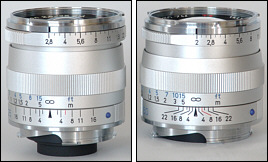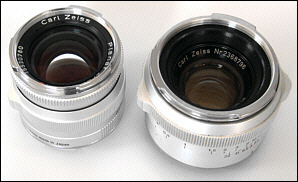 |
|
 |
||||||
|
|
|
|
|
|
|
|
||
The first thing is that these are manual focus lenses. That's right – you must focus on your own. No autofocus, no lens stabilization, no focusing aids, no silent motors. It's all manual – a throwback to the early days of photography.
Carl Zeiss has branded these as ZM lenses, presumably to mean that they are Zeiss designs for the M mount. Fair enough.
 25mm Biogon, left, and 50mm Planar. Note, that both lenses are about the same length from mounting bayonet to the front element. The Biogon appears longer because the rear element sits deeper in the body. |
Unlike many lens makers today, Carl Zeiss (and Leica) makes just one line of lenses – the best it can make. And it's evident in their construction: Heavy chromed steel and brass with no hint of plastic barrels or plastic lens elements.
The norm for the camera industry is random sampling to ensure quality, and we've all read numerous stories of lenses that have to be returned. No doubt, many fine lenses roll off mass production lines, and defects are considered part of the norm with this type of manufacturing.
With the higher cost of a Carl Zeiss lens (and a Leica lens, as well), buyers are less tolerant of defective lenses, as well they should be. Each lens arrives with its own signed (not stamped) quality control certificate. Does that mean you won't get a dog? Of course not, but it does provide a level of comfort to the buyer that a real person has inspected your lens before it was packaged.
All of the ZM lenses use Carl Zeiss's T* multicoating process, which helps to increase contrast and cut down on reflections inside the lens. It's a process that has been used quite successfully for decades.
Inspection of the 50mm Planar and 25mm Biogon shows nicely finished lenses with attention to detail. Aperture and distances are engraved and filled. The focal length of each is marked about 1 1/2 inches to the left of the depth of field scale. Click stops are in one-third stop increments. They are positive yet on the soft side. That is, they slip from stop to stop firmly but don't make a loud click. A tiny blue plastic dome is used for mounting purpose, indicating where the lens needs to be positioned. Leica lenses use a red dot.
 Carl Zeiss ZM 50mm Planar, left, and Carl Zeiss 50mm Contarex Planar. |
The rangefinder's close focus limit is 0.7 meters (roughly 27.5 inches), while the 25mm Biogon focuses to 0.5 meters. That means, the rangefinder disengages at 0.7 meters. When focusing closer than that, the secondary image in the rangefinder patch remains stationary. You probably can use the 0.5 meter mark for a hyperfocal setting. I'm going to try a few shots and see how easy this is to do.
The amount of effort required to focus is about the same with both lenses. I have to say that the Contarex lenses have always been some of the nicest lenses I've used in terms of optical performance and mechanical touch and feel. I'm expecting a similar experience with the ZM lenses.
If you as a camera user are looking to save money and find bargain lenses (less than $400), then this camera system might not be for you. At the least, you're going to have to wait a couple of years until the equipment begins to reach the used market.
The "Made in Japan" Carl Zeiss lenses for the Zeiss Ikon are less expensive than their Leica counterparts. The "Made in Germany" 15mm Distagon and 85mm Sonnar, however, are not. Both use floating elements, and Carl Zeiss says that Cosina didn't have the facilities to produce a lens with such a complex design.